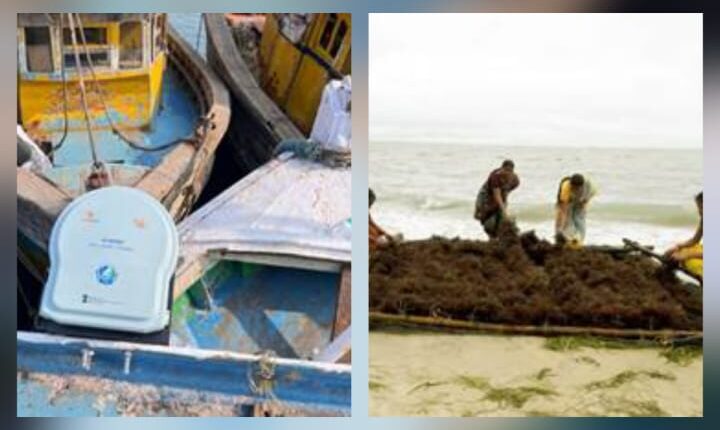Fishers and Farmers Chart Future of India’s Blue Revolution
Over 15,000 stakeholders connect virtually with policymakers in nationwide fisheries outreach
Aditi Agrawal (PIB)
New Delhi, Oct 4: In one of the largest consultative exercises of its kind, over 15,000 fishers and fish farmers from 34 States and Union Territories participated in a nationwide series of virtual feedback sessions organised by the Department of Fisheries (DoF), Ministry of Fisheries, Animal Husbandry and Dairying, between 2 April and 30 September 2025.
The extensive outreach, led by Dr. Abhilaksh Likhi, Secretary, Department of Fisheries, aimed to capture grassroots-level perspectives to shape India’s fisheries and aquaculture roadmap for the coming years.
The initiative brought together fishers, fish farmers, fisheries associations, cooperatives, Fisheries Farmer Producer Organizations (FFPOs), startups, ICAR institutions, the National Fisheries Development Board (NFDB), and State/UT Fisheries Departments, covering coastal, inland, hilly, island, and North-Eastern regions — ensuring representation from nearly every district across the country.
Dr. Likhi described the consultations as a “vital bridge between fishers, fish farmers, and policymakers.” He said, “The insights received will guide our interventions and ensure that growth in the sector remains inclusive, sustainable, and farmer-centric — in alignment with the Department’s five-year roadmap and the vision of Viksit Bharat 2047.”
The interactive sessions, conducted through mobile-based video conferencing, provided participants with a direct platform to share their challenges, aspirations, and recommendations from the comfort of their homes.
Fishers and fish farmers expressed appreciation for various government schemes, including the Pradhan Mantri Matsya Sampada Yojana (PMMSY), Pradhan Mantri Matsya Kisan Samridhi Sah-Yojana (PM-MKSSY), Fisheries and Aquaculture Infrastructure Development Fund (FIDF), Group Accident Insurance Scheme (GAIS), Blue Revolution, and Kisan Credit Card.
Stakeholders emphasized the urgent need for quality fish seed, brood banks, affordable feed, and the establishment of local feed mills. They also stressed the importance of strengthening transport facilities, cage culture, mini hatcheries, ice boxes, poly sheets, cold storage, and the integration of solar energy in aquaculture.
Participants strongly supported the government’s initiative of installing transponders free of cost on fishing vessels — a move that has enhanced maritime safety. These devices, fishers noted, help deliver Potential Fishing Zone (PFZ) advisories, weather and cyclone alerts, and prevent unintentional crossings of international maritime boundaries.
Fishers also proposed the adoption of innovative technologies such as drones for live-fish transport, satellite applications for monitoring and security, and digital systems for aquaculture management.
On the marketing front, participants called for the creation of dedicated fish markets, modern processing plants, and fish kiosks to improve value chains and ensure better price realization. They urged the expansion of PMMSY’s support for alternative livelihoods, including seaweed cultivation, ornamental fisheries, and pearl farming.
The importance of capacity building was also underscored — with demands for regular training programmes, disease control systems, aquatic health management, and water-quality testing laboratories.
The fisheries sector has emerged as one of India’s fastest-growing and most inclusive industries, sustaining the livelihoods of nearly 3 crore people, many from marginalised coastal and rural communities. India today stands as the world’s second-largest fish producer, contributing 8% of global output, and ranks second in global aquaculture production.
Since 2015, the Government of India has channelled ₹38,572 crore in cumulative investments through targeted schemes and initiatives. As a result, total fish production has reached 195 lakh tonnes, recording an annual growth rate of 8.74%, while seafood exports rose to ₹60,524 crore in 2023–24.
The Department has also notified 34 fisheries production and processing clusters and is developing species-specific clusters to strengthen value chains and promote women’s empowerment through FFPOs and cooperatives. This cluster-based approach is designed to boost domestic fish consumption, encourage exports, and secure livelihoods for small-scale fishers.
Officials confirmed that insights gathered from the six-month exercise will directly influence future policy interventions, infrastructure projects, and welfare measures for the sector. The consultations, they added, will help refine ongoing flagship schemes and align new programmes with India’s larger vision of “Viksit Bharat 2047.”
For thousands of participants, the consultations represented more than just dialogue — they were an affirmation of inclusion. As one coastal fisher put it, “For the first time, we spoke directly to those who shape policies. Our challenges were heard, and our voices counted.”
With India’s fisheries sector charting new waters in sustainability, technology, and global competitiveness, the government’s inclusive outreach has ensured that the voices from boats and ponds echo in the corridors of policymaking. (PIB)


Comments are closed.